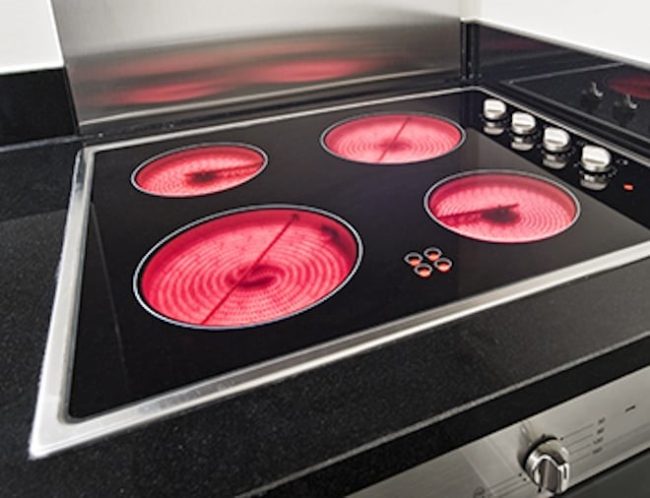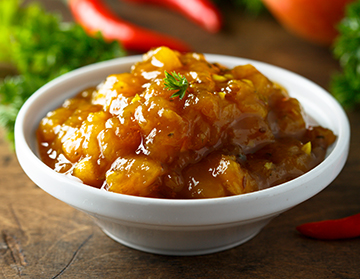
Can I Use My Ceramic Cooktop When Canning?
A common question asked during canning season is, “Can I use my glass or ceramic cooktop when canning?” To answer this question, begin by contacting your cooktop manufacturer to find out what they recommend. Then ask yourself, “Is it a good idea to use my ceramic cooktop when canning?” Here are some fundamentals to help you make an informed decision.

Cookware. Kettles and pans should be flat with a smooth bottom to provide stability and, more importantly, allow heat to be disbursed evenly. The cookware should not have rounded-edge bottoms, as this may cause uneven heating, which can place unnecessary stress on the ceramic glass. Therefore, the traditional ridged aluminum or porcelain-covered steel pots used in water bath canners are not recommended for use on these cooktops. Always read and follow the canner manufacturer’s directions as there are many canners that should never be used on a ceramic cooktop.
Additionally, the diameter of the burner should be large enough to adequately allow for even heating throughout the pot. Unfortunately, ceramic cooktops may not be able to meet the maximum diameter needed for canners.
Heavy or abrasive cookware. Heavy or abrasive cookware can damage the surface of the cooktop. Pay close attention to the manufacturer’s weight restrictions for your cooktop.
A general rule of thumb for weight restrictions on these cooktops is fifty pounds. However, contact your manufacturer for specific information regarding your cooktop. Be mindful of the weight of the items placed on the cooktop. You may exceed the weight recommendation depending on the type of canner used and the number of jars processed.
Additionally, use special care when moving canners. Avoid sliding or pulling the canner, which can scratch and damage the cooktop.
Safety Features. Most newer electric cooktops have built-in safety features with sensors that will cycle the burner off and on while on high to prevent damage from occurring due to extreme temperatures. If the cooktop remains on for an extended time, the sensors can turn off the burner after a set time. While this safety feature reduces the likelihood of damage to the cooktop, it may result in food being under-processed and unsafe.
The National Center for Home Food Preservation does not recommend ceramic cooktops for canning for good reasons, considering the many previously discussed factors. However, each brand and model of ceramic cooktops will be slightly different, so always begin by reading your manual and speaking with the manufacturer.
Source: National Center for Home Food Preservation, https://nchfp.uga.edu/publications/nchfp/factsheets/smoothtops.html(opens in new window)
Chutneys – A Different Kind of Pickled Product
Chutney is savory sauce or condiment most closely associated with Indian cuisine. Chutney is usually made from some type of fruit, vinegar, vegetables, and herbs and spices that are cooked down together to make a thick sauce. Chutney can be served with a variety of different meats, such as poultry and pork, or can be served as an accompaniment on a meat and cheese board. If you are looking for something new to make this summer, try this Mango Chutney recipe from the National Center for Home Food Preservation.

Mango Chutney
Yield: About 6 pint jars.
Ingredients:
- 11 cups or 4 pounds chopped unripe (hard) mango, either Tommy Atkins or Kent varieties (about 9 to 10 large whole mangoes, or 6 pounds, as purchased)
- 2½ cups finely chopped yellow onion (about 1 pound onions as purchased)
- 2½ tablespoons grated fresh ginger
- 1½ tablespoons finely chopped fresh garlic
- 4½ cups sugar
- 3 cups white distilled vinegar (5%)
- 2½ cups golden raisins
- 1½ teaspoon canning salt
- 4 teaspoons chili powder
Caution: Handling green mangoes may irritate the skin of some people in the same way as poison ivy. Wear plastic or rubber gloves while working with raw green mango. Do not touch your face, lips or eyes after touching or cutting raw green mangoes until all traces are washed away.
Procedure:
- Wash and rinse pint or half-pint canning jars; keep hot until ready to use. Prepare lids according to manufacturer’s directions.
- Wash all produce well. Peel, core, and chop mangoes into ¾ inch cubes. Chop mango cubes in food processor, using 6 one-second pulses per food processor batch. Do not puree or chop too finely. By hand, peel and dice onion, finely chop garlic, and grate ginger.
- Mix sugar and vinegar in a large stockpot. Bring to a boil, and boil 5 minutes. Add all other ingredients and bring back to a boil. Reduce heat and simmer, 25 minutes, stirring occasionally.
- Fill hot chutney into clean, hot pint or half-pint jars, leaving ½ inch headspace. Remove air bubbles and adjust headspace, if needed. Wipe rims of jars with a dampened, clean paper towel; adjust two-piece metal canning lids.
- Process in a boiling water canner according to the recommendations in the table below. Let cool, undisturbed for 12-24 hours and check for seals.
Process Time at Altitudes:
| Style of Pack: | Hot |
| Jar Size | Pints or Half-pints |
| 0 – 1,000 ft | 10 min |
| 1,001 – 6,000 ft | 15 min |
| Above 6,000 ft | 20 min |
Source: National Center for Home Food Preservation, https://nchfp.uga.edu/how/can_06/mango_chutney.html
Originally published by the University of Missouri Extension
Print or share this newsletter



